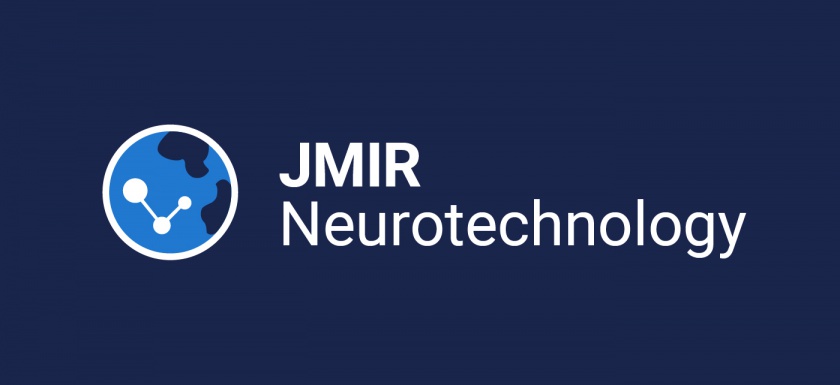
JMIR Publications is pleased to announce the expansion of their journal portfolio with JMIR Neurotechnology (JNT) a gold open access, peer-reviewed journal focused on the intersection between clinical neuroscience and technology to prevent, diagnose, and treat neurological disorders.
This journal was launched due to the fact that advances in many domains are providing valuable contributions, ranging from new findings from basic research aimed at unraveling applied behavioral approaches to improve neurological functions and health-related quality of life such as mindfulness and meditation training anchored in novel neurotechnology that provide both scientists and patients with new tools for research and treatment.
In this context, the journal pragmatically defines neurotechnology as the use of information technology to diagnose or treat chronic neurological disease.
Building on the JMIR Publications foundation, JMIR Neurotechnology intends to support development of novel diagnostic and treatment tools and paradigms for neurological diseases, leveraging recent insights from clinical neuroscience and information technology.
The hope is to foster explicit linking of two domains into a merged domain and single, coherent neurotechnology community, defined as “those exploring the use of technologies to diagnose and treat chronic neurological disease.”
This journal will support the development of novel diagnostic and treatment paradigms for neurological diseases, leveraging recent insights from clinical neuroscience and information technologies, with the explicit intention of linking these two domains so closely that they are forged into a combined domain and a coherent community of discussion, debate, and problem-solving.
Dr. Pieter Kubben, MD, PhD a Neurosurgeon from The Maastricht University Medical Center in the Netherlands and Editor-in-Chief of JMIR Neurotechnology said, “JNT aims to be a platform where applied human research can connect patients, caregivers, and information engineers active in any neurological domain where patient benefit is clear for all involved. JNT is not interested in fundamental neuroscience nor in animal research”
Kubben hopes that the journal will serve as a gathering place for all involved with patient care, whether directly or indirectly since we believe that understanding and managing chronic diseases is and must be a team endeavor, involving different people serving in a wide assortment of complementary roles.
JMIR Publications and JMIR Neurotechnology editors also recognize the value of public/private partnerships and hope the journal can support collaboration and foster sustainable innovation between these critical players.
These teams explicitly want to connect these various domains that typically are separate and hope to do so in part by including a short, author-written statement- which we call a “handshake box” with every article.
Authors of clinically-oriented articles will be asked to write a handshake text that concisely articulates the technical implications of their findings, and authors of technical work will similarly write handshake text to articulate the clinical implications of their work.
This Journal hopes to make authors feel comfortable in articulating their findings in digestible terms for all those involved in understanding neurological diseases. The worlds of all those involved in these challenges are not different and should be separated and the JMIR Neurotechnology handshake box is meant to close this common communication gap between domains.
Dr. Kubben concluded, “We warmly welcome you onto our JNT bridge and hope to see you there as part of our evolving community!”
###
DOI – https://doi.org/10.2196/41122
Full-text – https://neuro.jmir.org/2022/1/e41122
Free Altmetric Report – https://jmir.altmetric.com/details/doi/10.2196/41122
Keywords – neurotechnology, neurological disorders, treatment tools, chronic neurological disease, information technology
JMIR Publications is a leading, born-digital, open access publisher of 30+ academic journals and other innovative scientific communication products that focus on the intersection of health and technology. Its flagship journal, the Journal of Medical Internet Research, is the leading digital health journal globally in content breadth and visibility, and it is the largest journal in the medical informatics field.
To learn more about JMIR Publications, please visit https://www.JMIRPublications.com or connect with us via:
YouTube – https://www.youtube.com/c/JMIRPublications
Facebook – https://www.facebook.com/JMedInternetRes
Twitter – https://twitter.com/jmirpub
LinkedIn – https://www.linkedin.com/company/jmir-publications
Instagram – https://www.instagram.com/jmirpub/
Head Office – 130 Queens Quay East, Unit 1100 Toronto, ON, M5A 0P6 Canada
Media Contact – Communications@JMIR.org
The content of this communication is licensed under the terms of the Creative Commons Attribution License (https://creativecommons.org/licenses/by/4.0/), which permits unrestricted use, distribution, and reproduction in any medium, provided the original work, published by JMIR Publications, is properly cited.
JMIR Publications is a registered trademark of JMIR Publications.
